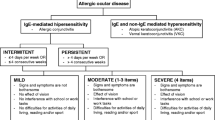Abstract
Atopic keratoconjunctivitis (AKC) is the most severe form of allergic conjunctivitis and, if inadequately treated, can cause vision loss. Treatment aims to minimize symptoms, recurrence and consequent eye rubbing, which cause long-term eye damage. First-line treatment generally involves the use of topical ophthalmic formulations of mast-cell stabilizers and/or antihistamines, corticosteroids, calcineurin inhibitors and immunomodulators (used in that order). Systemic formulations of these drugs can be used to treat refractory cases of AKC or when deemed appropriate for the individual.

Similar content being viewed by others
References
Hogan MJ. Atopic keratoconjunctivitis. Am J Ophthalmol. 1953;36(71):937–47.
Chen JJ, Applebaum DS, Sun GS, et al. Atopic keratoconjunctivitis: a review. J Am Acad Dermatol. 2014;70(3):569–75.
Bonini S, Gramiccioni C, Bonini M, et al. Practical approach to diagnosis and treatment of ocular allergy: a 1-year systematic review. Curr Opin Allergy Clin Immunol. 2007;7(5):446–9.
Ridolo E, Kihlgren P, Pellicelli I, et al. Atopic keratoconjunctivitis: pharmacotherapy for the elderly. Drugs Aging. 2019;36(7):581–8.
Nivenius E, Van der Ploeg I, Gafvelin G, et al. Conjunctival provocation with airborne allergen in patients with atopic keratoconjunctivitis. Clin Exp Allergy. 2012;42(1):58–65.
Bonini S. Atopic keratoconjunctivitis. Allergy. 2004;59(Suppl 78):71–3.
Ding W, Zou GL, Zhang W, et al. Interleukin-33: its emerging role in allergic diseases. Molecules. 2018. https://doi.org/10.3390/molecules23071665.
Lin J, Zhao GQ, Wang Q, et al. Regulation of interleukin 33/ST2 signaling of human corneal epithelium in allergic diseases. Int J Ophthalmol. 2013;6:23–9.
Leonardi A, Jose PJ, Zhan H, et al. Tear and mucus eotaxin-1 and eotaxin-2 in allergic keratoconjunctivitis. Ophthalmology. 2003;110(3):487–92.
Oshinskie L, Haine C. Atopic dermatitis and its ophthalmic complications. J Am Optom Assoc. 1982;53(11):889–94.
Rich LF, Hanifin JM. Ocular complications of atopic dermatitis and other eczemas. Int Ophthalmol Clin. 1985;25(1):61–76.
Zhan H, Smith L, Calder V, et al. Clinical and immunological features of atopic keratoconjunctivitis. Int Ophthalmol Clin. 2003;43(1):59–71.
Bielory L. Allergic and immunologic disorders of the eye. Part II: ocular allergy. J Allergy Clin Immunol. 2000;06(6):1019–32.
Tuft SJ, Ramakrishnan M, Seal DV, et al. Role of Staphylococcus aureus in chronic allergic conjunctivitis. Ophthalmology. 1992;99(2):180–4.
Guglielmetti S, Dart JK, Calder V. Atopic keratoconjunctivitis and atopic dermatitis. Curr Opin Allergy Clin Immunol. 2010;10(5):478–85.
Spergel JM. Immunology and treatment of atopic dermatitis. Am J Clin Dermatol. 2008;9(4):233–44.
Wakamatsu TH, Okada N, Kojima T, et al. Evaluation of conjunctival inflammatory status by confocal scanning laser microscopy and conjunctival brush cytology in patients with atopic keratoconjunctivitis (AKC). Mol Vis. 2009;15:1611–9.
Wise SK, Lin SY, Toskala E, et al. International consensus statement on allergy and rhinology: allergic rhinitis. Int Forum Allergy Rhinol. 2018;8(2):108–352.
Jabbehdari S, Starnes TW, Kurji KH, et al. Management of advanced ocular surface disease in patients with severe atopic keratoconjunctivitis. Ocul Surf. 2019;17(2):303–9.
Galor A, Jabs DA, Leder HA. Comparison of antimetabolite drugs as corticosteroid-sparing therapy for noninfectious ocular inflammation. Ophthalmology. 2008;115(10):1826–32.
Bielory L, Schoenberg D. Emerging therapeutics for ocular surface disease. Curr Allergy Asthma Rep. 2019;19(3):16.
Shaker M, Salcone E. An update on ocular allergy. Curr Opin Allergy Clin Immunol. 2016;16(5):505–10.
Lyseng-Williamson KA. Oral bepotastine: in allergic disorders. Drugs. 2010;70(12):1579–91.
Coondoo A, Phiske M, Verma S, et al. Side-effects of topical steroids: a long overdue revisit. Indian Dermatol Online J. 2014;5(4):416–25.
Attas-Fox L, Barkana Y, Iskhakov V, et al. Topical tacrolimus 0.03% ointment for intractable allergic conjunctivitis: an open-label pilot study. Curr Eye Res. 2008;33(7):545–9.
Hingorani M, Moodaley L, Calder VL, et al. A randomized, placebo-controlled trial of topical cyclosporin A in steroid-dependent atopic keratoconjunctivitis. Ophthalmology. 1998;105(9):1715–20.
Tesse R, Spadavecchia L, Fanelli P, et al. Treatment of severe vernal keratoconjunctivitis with 1% topical cyclosporine in an Italian cohort of 197 children. Pediatr Allergy Immunol. 2010;21(2 Pt 1):330–5.
Daniell M, Constantinou M, Vu HT, et al. Randomised controlled trial of topical ciclosporin A in steroid dependent allergic conjunctivitis. Br J Ophthalmol. 2006;90(4):461–4.
Miyazaki D, Tominaga T, Kakimaru-Hasegawa A, et al. Therapeutic effects of tacrolimus ointment for refractory ocular surface inflammatory diseases. Ophthalmology. 2008;115(6):988–92.e5.
Ridolo E, Montagni M, Bonzano L, et al. Bilastine: new insight into antihistamine treatment. Clin Mol Allergy. 2015;13(1):1.
Bousquet J, Ansotegui I, Canonica GW, et al. Establishing the place in therapy of bilastine in the treatment of allergic rhinitis according to ARIA: evidence review. Curr Med Res Opin. 2012;28(1):131–9.
Sologuren A, Vinas R, Cordon E, et al. Open-label safety assessment of bilastine in elderly patients with allergic rhinoconjunctivitis and/or urticaria. Allergy Asthma Proc. 2018;39(4):299–304.
Simons FE. Comparative pharmacology of H1 antihistamines: clinical relevance. Am J Med. 2002;113(Suppl 9A):38s–46s.
Stumpf T, Luqmani N, Sumich P, et al. Systemic tacrolimus in the treatment of severe atopic keratoconjunctivitis. Cornea. 2006;25(10):1147–9.
Hoang-Xuan T, Prisant O, Hannouche D, et al. Systemic cyclosporine A in severe atopic keratoconjunctivitis. Ophthalmology. 1997;104(8):1300–5.
Daniel E, Thorne JE, Newcomb CW, et al. Mycophenolate mofetil for ocular inflammation. Am J Ophthalmol. 2010;149(3):423–32.
Hornbeak DM, Thorne JE. Immunosuppressive therapy for eye diseases: effectiveness, safety, side effects and their prevention. Taiwan J Ophthalmol. 2015;5(4):156–63.
Author information
Authors and Affiliations
Consortia
Ethics declarations
Conflict of interest
The article was adapted from Drugs and Aging 2019; 36(7) 581–88 [4] by employees of Adis International Ltd./Springer Nature, who are responsible for the article content and declare no conflicts of interest.
Funding
The preparation of this review was not supported by any external funding.
Rights and permissions
About this article
Cite this article
Adis Medical Writers. Act quickly when treating atopic keratoconjunctivitis to avoid adverse outcomes. Drugs Ther Perspect 36, 17–22 (2020). https://doi.org/10.1007/s40267-019-00694-w
Published:
Issue Date:
DOI: https://doi.org/10.1007/s40267-019-00694-w




